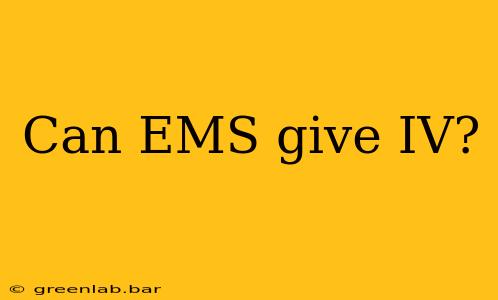Can EMS Give IVs? A Comprehensive Look at Emergency Medical Services and Intravenous Therapy
The question of whether Emergency Medical Services (EMS) personnel can administer IVs is complex and depends heavily on several factors, including location, training level of the EMS provider, and the specific protocols in place. There's no simple yes or no answer.
Varying Levels of EMS Training and Scope of Practice
EMS providers are not a monolithic group. They are categorized into different levels of training and certification, each with a specific scope of practice. These levels vary significantly across different regions and countries. In some areas:
-
Emergency Medical Technicians (EMTs): Basic level providers. In many jurisdictions, EMTs are not authorized to administer IVs. Their focus is on basic life support, including airway management, bleeding control, and oxygen administration.
-
Advanced Emergency Medical Technicians (AEMTs) / Paramedics: These providers possess advanced training and certifications. Many, but not all, AEMTs and paramedics are trained and authorized to administer IV fluids and medications via the intravenous route. This advanced training includes extensive knowledge of vascular anatomy, medication administration, fluid balance, and potential complications.
Scope of Practice Determined by Local Regulations
Even within the advanced provider categories (AEMTs/Paramedics), the ability to administer IVs is strictly governed by local regulations and medical director oversight. The specific protocols and standing orders issued by a medical director determine the exact scope of practice for EMS personnel in a given region or service. This means:
-
State-to-State Differences: What's permissible in one state may be prohibited in another. Regulations can vary significantly, reflecting differing healthcare systems and levels of resources.
-
Protocol Variations: Even within a single state, different EMS agencies may have different protocols based on their specific needs and the expertise of their personnel.
Why the Variation Exists?
The restrictions on IV administration for some EMS levels stem from considerations of safety and liability. Intravenous therapy, while vital in emergency care, carries potential risks including:
- Infection: Improper insertion technique can lead to infection at the IV site.
- Infiltration: The IV fluid may leak into surrounding tissues.
- Thrombophlebitis: Inflammation of the vein.
- Air embolism: Accidental introduction of air into the bloodstream.
Higher levels of training and experience mitigate these risks. The rigorous training for AEMTs/Paramedics provides them with the necessary skills to safely and effectively administer IV therapy.
In Conclusion: It Depends
Whether EMS can give IVs hinges on the specific training level of the provider and the legal and regulatory framework within their operating jurisdiction. While advanced providers (AEMTs/Paramedics) often possess this capability, basic EMTs generally do not. Always defer to local protocols and guidelines for definitive answers.

